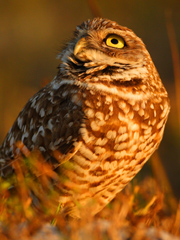WESTERN BURROWING OWL } Athene cunicularia hypugaea

|
RANGE: From the Mississippi River to the Pacific Ocean, north into Canada and south to Mexico and western Panama; in California, found throughout the Central Valley and in the northeastern and southern portions of the state
STATUS: Not listed under the Endangered Species Act; NatureServe deems the species Apparently Secure despite the fact that it’s subject to “substantial decline of 50 to 90 percent”
THREATS: Habitat loss and fragmentation from urban development, elimination of burrowing rodents, intensive agriculture, destruction of burrows, pesticides, predation by nonnative species, vehicle strikes, electric fences, collisions with wind turbines, and shooting
The burrowing owl isn’t your average owl: instead of in trees, it makes its nest underground — usually in rodent burrows abandoned by other animals — and it’s up and about both day and night. But the charismatic western burrowing owl isn’t just special; it’s also increasingly rare. Early accounts of the western burrowing owl in California described it as one of the most common birds in the state. In the late 1860s, according to one ornithologist, “burrowing owls stood on every little knoll” around San Diego. But the state’s population explosion and rapid development has reduced the western burrower’s breeding populations by more than 60 percent — and they’re still in decline.
Trivia fact: Carl Hiaasen's young adult novel Hoot (2002) is about a group of school kids trying to save the home of Florida burrowing owls in a small town; live burrowing owls were featured in the movie version.
LEARN MORE ABOUT THE WESTERN BURROWING OWL
|